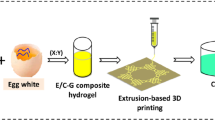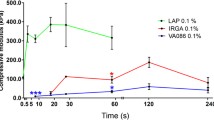Abstract
Extracellular matrix mimetic hydrogels which hybridize synthetic and natural polymers offer molecularly-tailored, bioactive properties and tunable mechanical strength. In addition, 3D bioprinting by stereolithography allows fabrication of internal pores and defined macroscopic shapes. In this study, we formulated a hybrid biocompatible resin using natural and synthetic polymers (chitosan and polyethylene glycol diacrylate (PEGDA), respectively) by controlling molecular weight of chitosan, feed-ratios, and photo-initiator concentration. Ear-shaped, hybrid scaffolds were fabricated by a stereolithographic method using a 405 nm laser. Hybrid hydrogel scaffolds of chitosan (50–190 kDa) and PEGDA (575 Da) were mixed at varying feed-ratios. Some of the cationic, amino groups of chitosan were neutralized by dialysis in acidic solution containing chitosan in excess of sodium acetate solution to inhibit quenching of newly formed photoradicals. A feed-ratio of 1:7.5 was found to be the most appropriate of the formulations considered in this study in terms of mechanical properties, cell adhesion, and printability. The biofabricated hybrid scaffold showed interconnected, homogeneous pores with a nominal pore size of 50 µm and an elastic modulus of ~400 kPa. Moreover, long-term cell viability and cell spreading was observed via actin filament staining. Printability of the biocompatible resin was confirmed by printing thresholded MR images of an ear and the feed ratio of 1:7.5 provided the most faithful reproduction of the shape. To the best of our knowledge, this is the first report of stereolithographic printing hybridizing cell-adhesive properties of chitosan with mechanical robustness of PEG in scaffolds suitable for repair of complex tissue geometries, such as those of the human ear.







Similar content being viewed by others
References
Akopova, T. A., T. S. Demina, V. N. Bagratashvili, K. N. Bardakova, M. M. Novikov, I. I. Selezneva, A. V. Istomin, E. A. Svidchenko, G. V. Cherkaev, N. M. Surin, and P. S. Timashev. Solid state synthesis of chitosan and its unsaturated derivatives for laser microfabrication of 3D scaffolds. IOP Conference Series: Materials Science and Engineering, Vol. 87, p. 012079, 2015.
Annabi, N., J. W. Nichol, X. Zhong, C. Ji, S. Koshy, A. Khademhosseini, and F. Dehghani. Controlling the porosity and microarchitecture of hydrogels for tissue engineering. Tissue Eng. Part B Rev. 16:371–383, 2010.
Bajaj, P., R. M. Schweller, A. Khademhosseini, J. L. West, and R. Bashir. 3D biofabrication strategies for tissue engineering and regenerative medicine. Annu. Rev. Biomed. Eng. 16:247–276, 2014.
Barron, J. A., P. Wu, H. D. Ladouceur, and B. R. Ringeisen. Biological laser printing: a novel technique for creating heterogeneous 3-dimensional cell patterns. Biomed. Microdevices 6:139–147, 2004.
Blan, N. R., and R. K. Birla. Design and fabrication of heart muscle using scaffold-based tissue engineering. J. Biomed. Mater. Res. A 86:195–208, 2008.
Boland, T., V. Mironov, A. Gutowska, E. A. Roth, and R. R. Markwald. Cell and organ printing 2: fusion of cell aggregates in three-dimensional gels. Anat. Rec. A Discov. Mol. Cell. Evol. Biol. 272:497–502, 2003.
Chan, P., M. Kurisawa, J. E. Chung, and Y. Y. Yang. Synthesis and characterization of chitosan-g-poly(ethylene glycol)-folate as a non-viral carrier for tumor-targeted gene delivery. Biomaterials 28:540–549, 2007.
Chan, V., P. Zorlutuna, J. H. Jeong, H. Kong, and R. Bashir. Three-dimensional photopatterning of hydrogels using stereolithography for long-term cell encapsulation. Lab Chip 10:2062–2070, 2010.
Chia, H. N., and B. M. Wu. Recent advances in 3D printing of biomaterials. J. Biol. Eng. 9:1, 2015.
Chung, C., J. Mesa, G. J. Miller, M. A. Randolph, T. J. Gill, and J. A. Burdick. Effects of auricular chondrocyte expansion on neocartilage formation in photocrosslinked hyaluronic acid networks. Tissue Eng. 12:2665–2673, 2006.
Drira, Z., and V. K. Yadavalli. Nanomechanical measurements of polyethylene glycol hydrogels using atomic force microscopy. J. Mech. Behav. Biomed. Mater. 18:20–28, 2013.
Gaebel, R., N. Ma, J. Liu, J. Guan, L. Koch, C. Klopsch, M. Gruene, A. Toelk, W. Wang, P. Mark, F. Wang, B. Chichkov, W. Li, and G. Steinhoff. Patterning human stem cells and endothelial cells with laser printing for cardiac regeneration. Biomaterials 32:9218–9230, 2011.
Geckil, H., F. Xu, X. Zhang, S. Moon, and U. Demirci. Engineering hydrogels as extracellular matrix mimics. Nanomedicine (Lond). 5:469–484, 2010.
Grieshaber, S. E., A. J. Farran, S. Lin-Gibson, K. L. Kiick, and X. Jia. Synthesis and characterization of elastin-mimetic hybrid polymers with multiblock, alternating molecular architecture and elastomeric properties. Macromolecules 42:2532–2541, 2009.
Hern, D. L., and J. A. Hubbell. Incorporation of adhesion peptides into nonadhesive hydrogels useful for tissue resurfacing. J. Biomed. Mater. Res. 39:266–276, 1998.
Hollister, S. J., R. D. Maddox, and J. M. Taboas. Optimal design and fabrication of scaffolds to mimic tissue properties and satisfy biological constraints. Biomaterials 23:4095–4103, 2002.
Jung, S., and H. Yi. Fabrication of chitosan-poly(ethylene glycol) hybrid hydrogel microparticles via replica molding and its application toward facile conjugation of biomolecules. Langmuir 28:17061–17070, 2012.
Kang, H. W., and D. W. Cho. Development of an indirect stereolithography technology for scaffold fabrication with a wide range of biomaterial selectivity. Tissue Eng. Part C Methods. 18:719–729, 2012.
Lee, W., T. G. Lee, and W. G. Koh. Grafting of poly(acrylic acid) on the poly(ethylene glycol) hydrogel using surface-initiated photopolymerization for covalent immobilization of collagen. J. Ind. Eng. Chem. 13:1195–1200, 2007.
Ma, G., X. Zhang, J. Han, G. Song, and J. Nie. Photo-polymeriable chitosan derivative prepared by Michael reaction of chitosan and polyethylene glycol diacrylate (PEGDA). Int. J. Biol. Macromol. 45:499–503, 2009.
Mazzoccoli, J. P., D. L. Feke, H. Baskaran, and P. N. Pintauro. Mechanical and cell viability properties of crosslinked low- and high-molecular weight poly(ethylene glycol) diacrylate blends. J. Biomed. Mater. Res. Part A 93A:558–566, 2010.
Nakamura, M., A. Kobayashi, F. Takagi, A. Watanabe, Y. Hiruma, K. Ohuchi, Y. Iwasaki, M. Horie, I. Morita, and S. Takatani. Biocompatible inkjet printing technique for designed seeding of individual living cells. Tissue Eng. 11:1658–1666, 2005.
Nuttelman, C. R., M. A. Rice, A. E. Rydholm, C. N. Salinas, D. N. Shah, and K. S. Anseth. Macromolecular monomers for the synthesis of hydrogel niches and their application in cell encapsulation and tissue engineering. Prog. Polym. Sci. 33:167–179, 2008.
Nuttelman, C. R., M. C. Tripodi, and K. S. Anseth. Synthetic hydrogel niches that promote hMSC viability. Matrix Biol. 24:208–218, 2005.
Pattanayak, D. K., A. Fukuda, T. Matsushita, M. Takemoto, S. Fujibayashi, K. Sasaki, N. Nishida, T. Nakamura, and T. Kokubo. Bioactive Ti metal analogous to human cancellous bone: fabrication by selective laser melting and chemical treatments. Acta Biomater. 7:1398–1406, 2011.
Pourjavadi, A., and G. R. Mahdavinia. Superabsorbency, pH-sensitivity and swelling kinetics of partially hydrolyzed chitosan-g-poly(acrylamide) hydrogels. Turk. J. Chem. 30:595–608, 2006.
Rafat, M., F. Li, P. Fagerholm, N. S. Lagali, M. A. Watsky, R. Munger, T. Matsuura, and M. Griffith. PEG-stabilized carbodiimide crosslinked collagen-chitosan hydrogels for corneal tissue engineering. Biomaterials 29:3960–3972, 2008.
Samuels, R. J. Solid-state characterization of the structure of chitosan films. J. Polymer Sci. Part B-Polymer Phys. 19:1081–1105, 1981.
Wang, W., G. Li, and Y. Huang. Modeling of bubble expansion-induced cell mechanical profile in laser-assisted cell direct writing. J. Manuf. Sci. Eng.-Trans. ASME 131:051013, 2009.
Zhu, J. Bioactive modification of poly(ethylene glycol) hydrogels for tissue engineering. Biomaterials 31:4639–4656, 2010.
Zhu, J. M., J. A. Beamish, C. Tang, K. Kottke-Marchant, and R. E. Marchant. Extracellular matrix-like cell-adhesive hydrogels from RGD-containing poly(ethylene glycol) diacrylate. Macromolecules 39:1305–1307, 2006.
Zhu, J., and R. E. Marchant. Design properties of hydrogel tissue-engineering scaffolds. Expert Rev. Med. Devices 8:607–626, 2011.
Zhu, Y., H. Xuan, J. Ren, and L. Ge. Self-healing multilayer polyelectrolyte composite film with chitosan and poly(acrylic acid). Soft Matter 11:8452–8459, 2015.
Acknowledgments
This material is based upon work supported partially by the National Science Foundation (Grant Number DMR-1306665). Any opinions, findings, conclusions, and recommendations expressed in this material are those of the authors and do not necessarily reflect the views of the National Science Foundation.
Author information
Authors and Affiliations
Corresponding author
Additional information
Associate Editor Jos Malda oversaw the review of this article.
Viola B. Morris and Siddharth Nimbalkar have contributed equally to this study.
Rights and permissions
About this article
Cite this article
Morris, V.B., Nimbalkar, S., Younesi, M. et al. Mechanical Properties, Cytocompatibility and Manufacturability of Chitosan:PEGDA Hybrid-Gel Scaffolds by Stereolithography. Ann Biomed Eng 45, 286–296 (2017). https://doi.org/10.1007/s10439-016-1643-1
Received:
Accepted:
Published:
Issue Date:
DOI: https://doi.org/10.1007/s10439-016-1643-1




